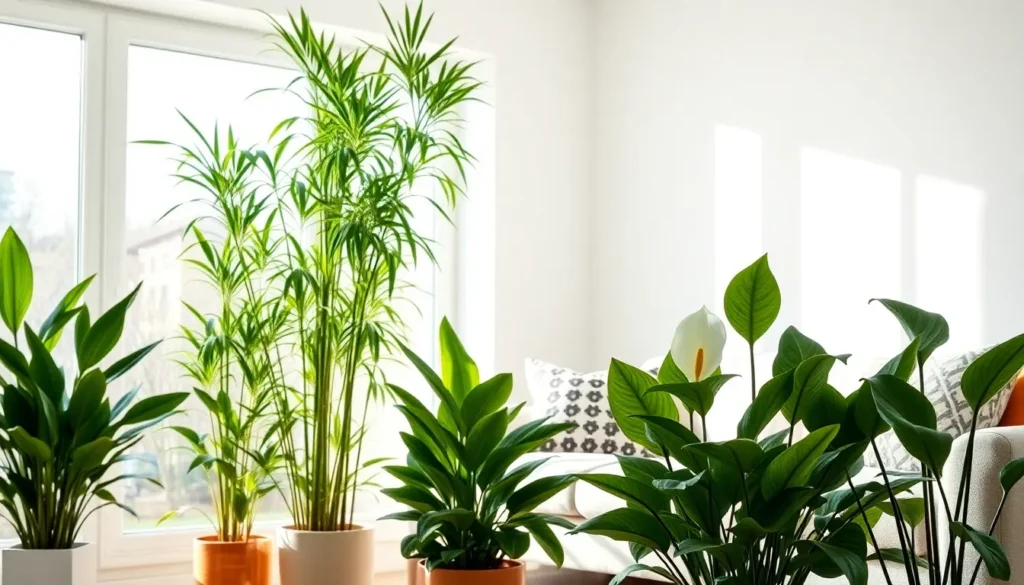Transform your home into a natural air purification system – it’s easier than you think. We spend roughly 90% of our time indoors, yet most of us don’t realize we’re breathing air that’s often more polluted than what’s outside. Common household items like cleaning products, furniture, and electronics constantly release harmful chemicals into our living spaces.
Nature offers us a beautiful solution. Certain houseplants don’t just add greenery to our homes – they actively filter toxins from the air we breathe. NASA’s groundbreaking Clean Air Study identified exact plants that can eliminate dangerous compounds like formaldehyde, benzene, and ammonia from indoor environments.
We’ll explore the most effective air-purifying plants that are both beautiful and functional. Whether you’re a seasoned plant parent or just starting your indoor garden journey, these natural air filters will help you create healthier living spaces while adding life and color to every room.
Snake Plant: The Ultimate Low-Maintenance Air Purifier
NASA’s research identified the snake plant as one of the most effective natural air purifiers for modern homes. We’ve found this striking succulent delivers exceptional air cleaning benefits while requiring virtually no care.
Removes Formaldehyde and Benzene
Formaldehyde removal ranks among the snake plant’s most impressive abilities. NASA’s study shows these hardy plants can filter out formaldehyde from furniture, carpets, and building materials throughout your home. Benzene elimination also occurs naturally as the plant processes indoor air through its thick, sword-like leaves.
Chemical compounds from cleaning products, paints, and synthetic fabrics get absorbed by the plant’s unique cellular structure. Studies demonstrate that a single snake plant can purify air in rooms up to 100 square feet effectively. Toxic gas absorption happens continuously, making your indoor environment safer for daily living.
Thrives in Low Light Conditions
Low light environments suit snake plants perfectly, unlike many other air purifying species. We recommend placing them in corners, hallways, or rooms with minimal natural sunlight where other plants typically struggle. Fluorescent office lighting provides sufficient energy for healthy growth and air purification.
Basement areas and interior rooms benefit greatly from snake plant placement. These adaptable plants maintain their air cleaning efficiency even in spaces that receive only artificial lighting. Window placement isn’t necessary, giving you flexibility to position them where air purification is needed most.
Requires Minimal Watering
Watering frequency for snake plants averages once every 2-3 weeks during growing season. We suggest allowing the soil to dry completely between waterings to prevent root rot and maintain plant health. Winter months require even less frequent watering, sometimes extending to monthly intervals.
Overwatering causes more damage than drought conditions for these resilient plants. Soil moisture checking involves inserting your finger 2 inches deep into the potting mix before deciding to water. Neglect actually benefits snake plants, making them perfect for busy households or frequent travelers seeking continuous air purification.
Peace Lily: Elegant Beauty With Powerful Purification
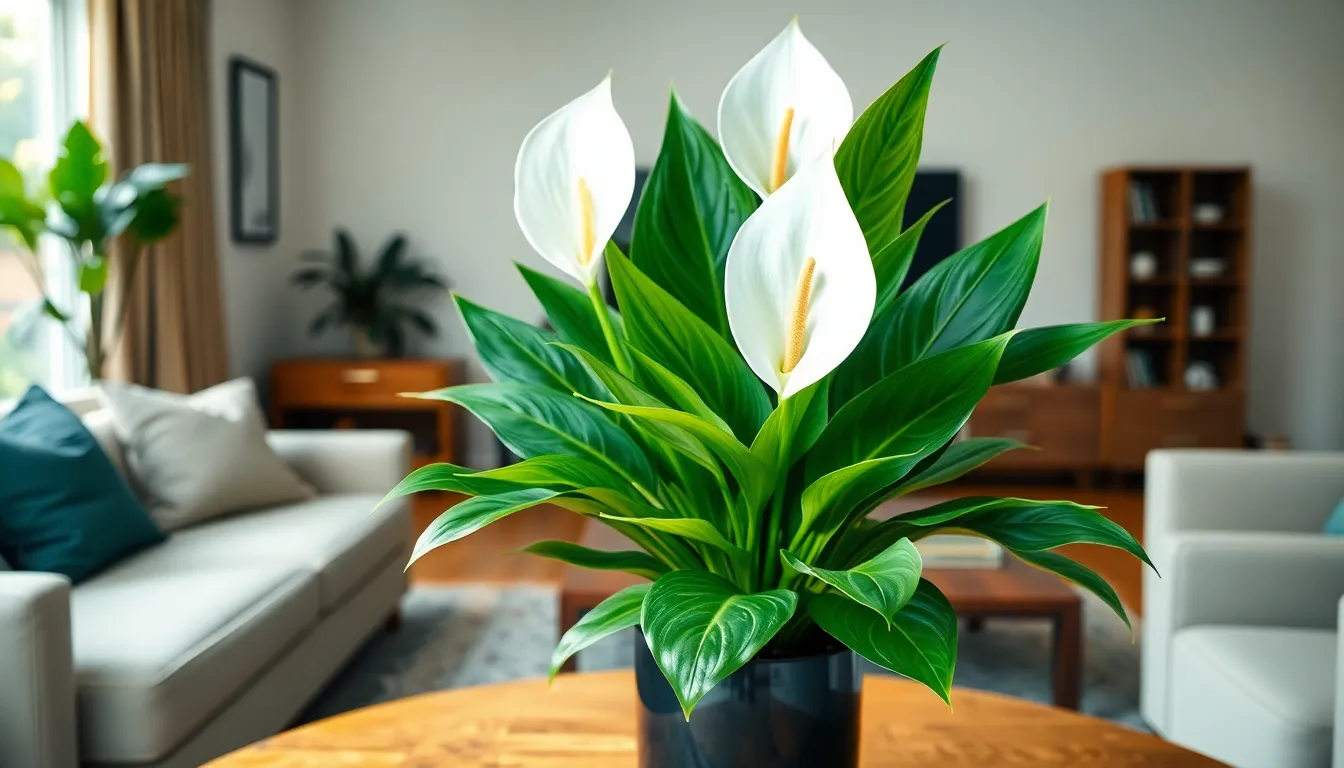
While snake plants excel at basic air purification, we find peace lilies offer superior filtration capabilities with added visual appeal. These elegant houseplants combine powerful air cleaning properties with stunning aesthetics.
Eliminates Ammonia and Acetone
Peace lilies target exact harmful chemicals that other plants can’t effectively remove. Ammonia and acetone are two particularly toxic compounds that peace lilies absorb through their leaves and root systems. These chemicals commonly enter our homes through cleaning products, nail polish removers, and certain synthetic materials.
Beyond ammonia and acetone, peace lilies also filter out benzene, formaldehyde, trichloroethylene, and xylene from indoor air. This comprehensive filtration makes them one of the most versatile air purifying plants we can choose for our homes. The NASA Clean Air Study specifically recognized peace lilies for their exceptional ability to remove these six different pollutants simultaneously.
Indicates Watering Needs Through Drooping
Drooping leaves serve as the peace lily’s natural communication system with us. When the plant needs water, its leaves will visibly droop and appear wilted, providing an unmistakable signal that it’s time to water. This unique feature eliminates the guesswork that often comes with plant care.
Once we water a drooping peace lily, the leaves typically perk up within hours, confirming that we’ve addressed its needs correctly. This responsive behavior makes peace lilies particularly suitable for new plant owners who are still learning to read their plants’ signals. We don’t need to follow strict watering schedules or worry about overwatering when the plant tells us exactly what it needs.
Blooms Beautiful White Flowers
White flowers emerge from peace lilies as elegant spoon shaped blooms that add sophistication to any indoor space. These striking white spathes appear above the dark green foliage, creating a stunning contrast that enhances our home’s aesthetic appeal. The flowers can last for several weeks, providing long lasting beauty alongside continuous air purification.
Flowering typically occurs when peace lilies receive adequate light and proper care, though they don’t require direct sunlight to bloom. Each flower consists of a white spathe surrounding a cream colored spadix, creating the plant’s signature elegant appearance. These blooms make peace lilies perfect for decorating living rooms, bedrooms, or office spaces where we want both clean air and visual appeal.
Spider Plant: Fast-Growing Champion of Clean Air
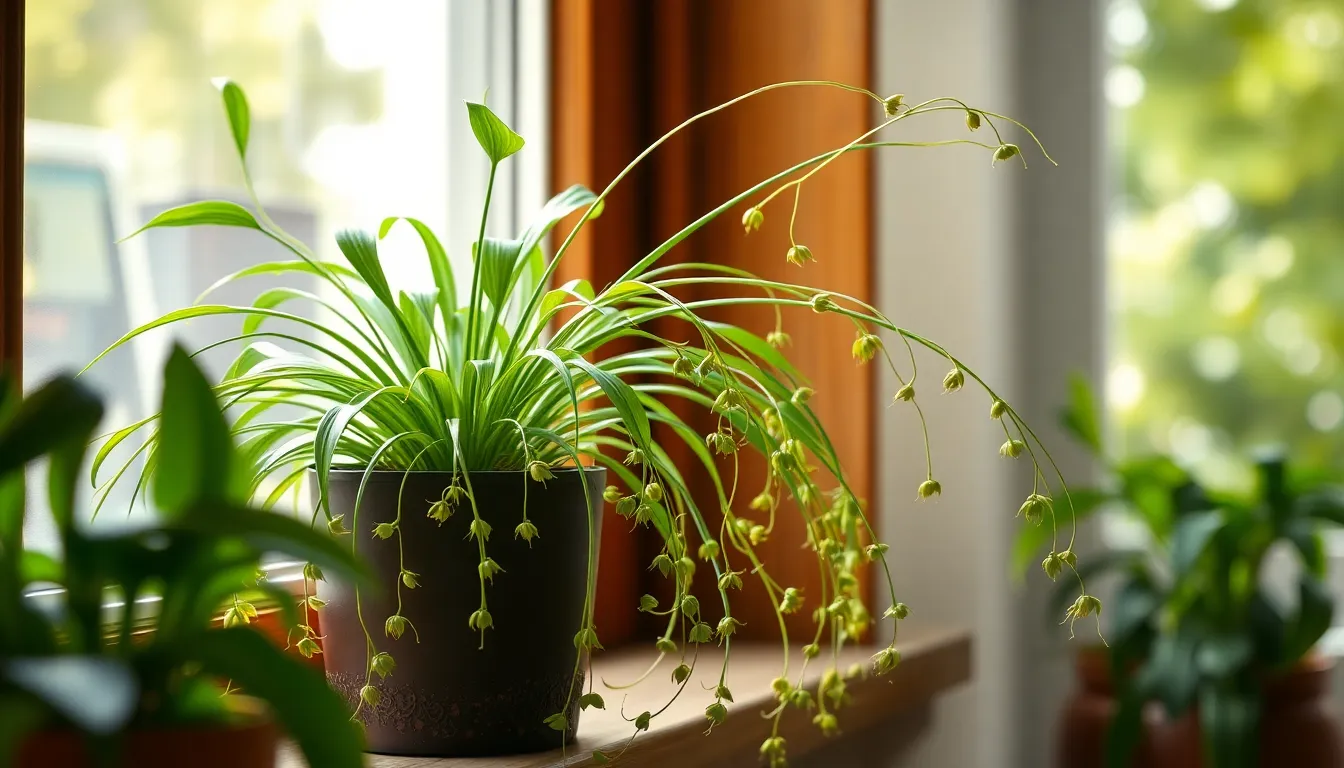
We’ve discovered another powerhouse in our air-purifying plant collection—the spider plant (Chlorophytum comosum). This remarkable houseplant combines exceptional air-cleaning abilities with rapid growth and stunning visual appeal.
Filters Xylene and Toluene
Spider plants excel at removing two particularly harmful volatile organic compounds from our indoor environments. Xylene and toluene are common pollutants that regularly enter our homes through paints, solvents, and everyday household products. These chemicals can cause headaches, dizziness, and respiratory irritation when we’re exposed to them over time.
Our spider plants actively absorb these toxins through their leaves, roots, and the beneficial microorganisms living in their soil. NASA’s Clean Air Study specifically identified spider plants as effective formaldehyde and VOC removers, placing them alongside other top-performing air purifiers. This natural filtration system works continuously, providing us with cleaner, safer air throughout the day.
Produces Baby Plants for Easy Propagation
Spider plants offer us a unique advantage that most other houseplants can’t match—they naturally create offspring called “baby plants” or plantlets. These small versions of the parent plant grow on long, arching stems called stolons, creating an attractive cascading effect.
Propagating these baby plants couldn’t be simpler for us. We can either cut the plantlets and root them in water, or leave them attached to the mother plant until they develop their own root systems. This incredible ability means we can easily expand our air-purifying plant collection throughout our home or share plants with friends and family without any additional cost.
Adapts to Various Light Conditions
Spider plants demonstrate remarkable flexibility when it comes to lighting requirements, making them perfect for nearly any room in our homes. These resilient plants thrive in indirect light conditions, which describes most typical indoor environments where we spend our time.
We can successfully place spider plants in corners, hallways, or rooms with minimal natural sunlight, and they’ll continue to grow and purify our air effectively. This adaptability, combined with their low maintenance needs, positions spider plants as one of our best choices for improving home air quality without requiring exact lighting setups or frequent care adjustments.
Rubber Tree: Large Leaves for Maximum Air Cleaning
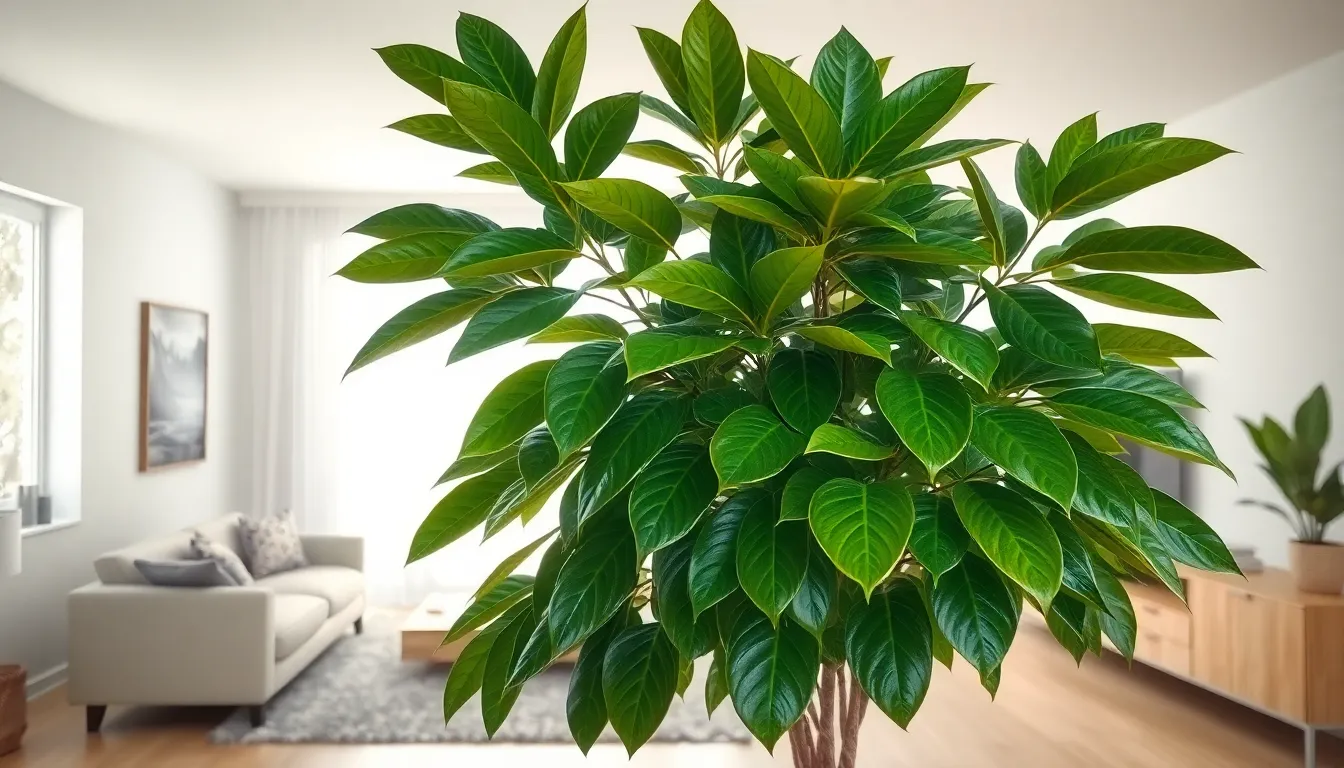
Rubber trees stand out among air-purifying plants for their exceptional ability to filter harmful chemicals through their distinctive large foliage. NASA research confirms that these impressive plants excel at removing toxic compounds from indoor environments.
Removes High Levels of Formaldehyde
Rubber trees demonstrate remarkable effectiveness at eliminating formaldehyde from indoor air. We’ve found that their large leaves provide substantial surface area for absorbing this harmful pollutant commonly found in furniture, carpets, and paints. The plant’s broad foliage acts as a natural filter, continuously working to reduce formaldehyde concentrations in our living spaces.
Formaldehyde removal happens through the leaves, which transport absorbed toxins to the roots where they’re broken down in the soil. This natural process makes rubber trees particularly valuable for homes with new furniture or recent renovations where formaldehyde levels tend to be highest.
Grows Into an Impressive Indoor Tree
Rubber trees transform into stunning indoor specimens that add important aesthetic value to our homes. These plants can develop into impressive trees with their glossy, dark green leaves creating a dramatic natural focal point in any room. Their vertical growth pattern makes them ideal for corners or areas where we want to add height and visual interest.
The plant’s natural tree-like structure provides both beauty and function, combining air purification with striking indoor landscaping. Mature rubber trees can reach several feet in height indoors, making them perfect statement plants that deliver maximum air cleaning benefits.
Requires Bright, Indirect Light
Rubber trees thrive in bright, indirect light conditions while avoiding direct sunlight that can scorch their leaves. We recommend placing them near windows where they receive filtered morning sunlight, which maintains their air-purifying efficiency and overall health. These plants tolerate dim indoor lighting conditions well, making them adaptable to various room settings.
Watering every 1-2 weeks keeps rubber trees healthy and functioning optimally. Their light requirements make them suitable for most indoor environments, from living rooms to offices, where they can continuously filter formaldehyde and other pollutants from our air.
Boston Fern: Humidity-Loving Air Freshener
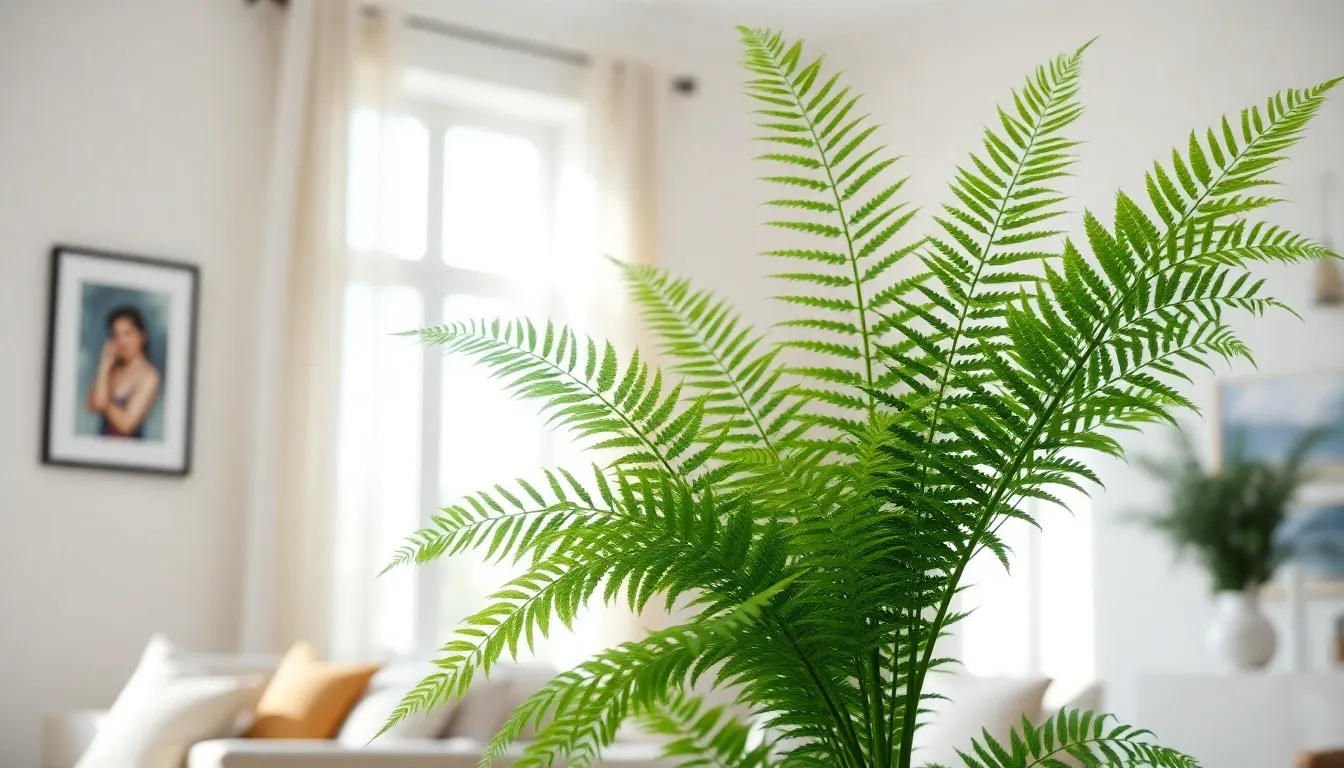
Boston ferns bring exceptional air purification capabilities to your home while simultaneously addressing dry indoor air conditions. We’ve found this feathery houseplant offers dual benefits that make it particularly valuable for maintaining healthier indoor environments.
Eliminates Formaldehyde and Xylene
Formaldehyde and xylene removal stands as the Boston fern’s primary air cleaning strength. These harmful chemicals commonly originate from paints, furniture, and synthetic materials throughout our homes. Boston ferns actively filter these pollutants through their delicate fronds, continuously working to reduce toxic concentrations in your living spaces.
Xylene exposure typically occurs from household items like adhesives, rubber, and leather products. Formaldehyde emissions come from pressed wood furniture, carpets, and various building materials. We recommend placing Boston ferns in rooms with new furniture or recent renovations where these chemical concentrations tend to be highest.
Adds Natural Moisture to Dry Indoor Air
Natural humidity enhancement makes Boston ferns particularly beneficial during winter months when indoor air becomes excessively dry. These plants release moisture through their leaves, naturally increasing humidity levels in your home environment. We’ve observed that Boston ferns can significantly improve air quality in spaces with low humidity conditions.
Dry indoor air often causes respiratory irritation, skin problems, and increased susceptibility to illness. Boston ferns combat these issues by continuously adding moisture to surrounding air. Their transpiration process creates a more comfortable breathing environment while supporting overall respiratory health.
Prefers Cool, Humid Environments
Cool, humid conditions align perfectly with Boston ferns’ natural habitat requirements and maximize their air purifying efficiency. These plants thrive in temperatures between 60 to 70 degrees Fahrenheit with consistent moisture levels. We suggest placing them in bathrooms, kitchens, or other naturally humid areas of your home.
Consistent soil moisture ensures optimal health and purification performance from your Boston fern. Indirect light provides the perfect growing conditions without causing leaf burn or stress. Their preference for humid environments makes them ideal companions for other moisture loving plants, creating natural humidity zones throughout your living space.
Aloe Vera: Dual-Purpose Plant for Air and Health
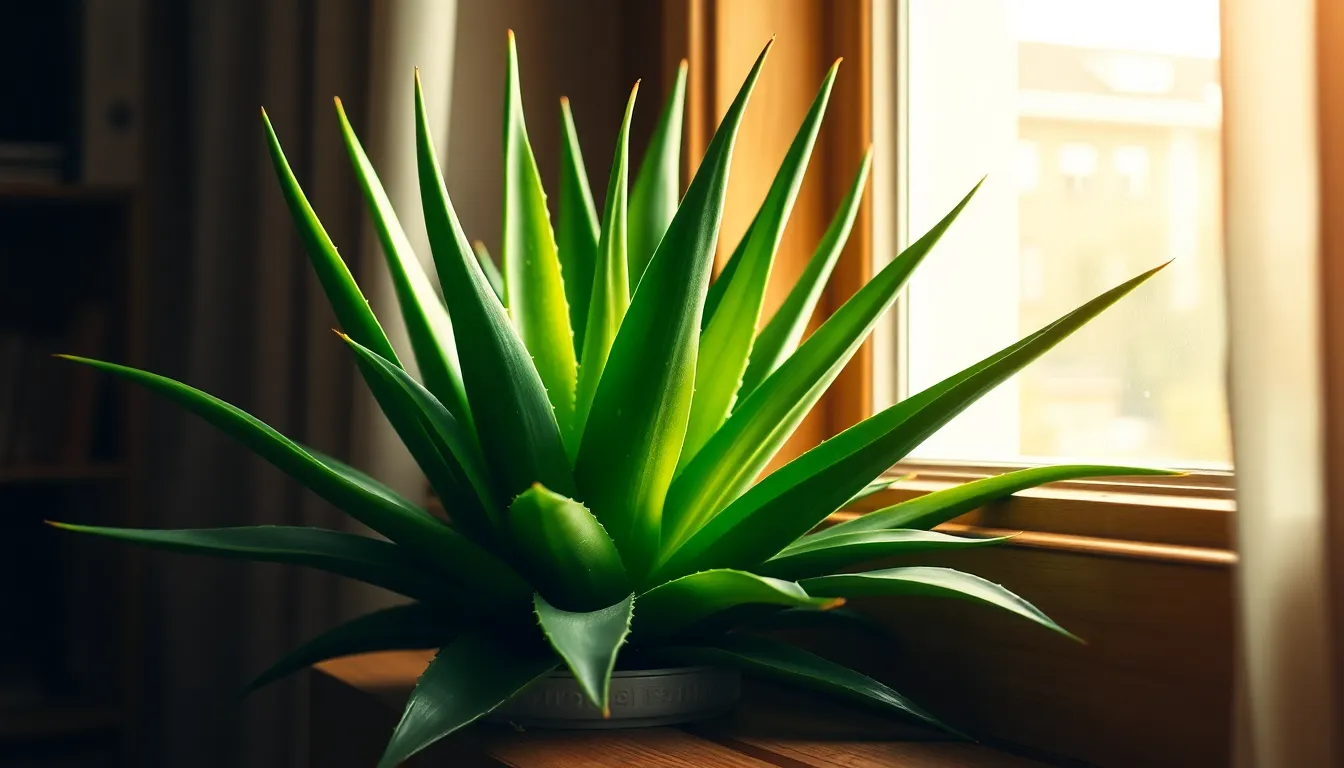
Aloe vera stands out as one of the most versatile houseplants we can choose for our homes. This succulent offers both air purification benefits and healing properties that make it an exceptional addition to any indoor space.
Removes Formaldehyde and Benzene
Aloe vera effectively filters formaldehyde and benzene from indoor air, targeting two of the most common household toxins. These harmful chemicals enter our homes through furniture finishes, cleaning products, and synthetic materials, creating potential health risks over time. NASA’s research confirms that aloe vera plants actively absorb these pollutants through their thick, fleshy leaves.
Formaldehyde concentrations decrease significantly when we place aloe vera plants in rooms with new furniture or recent renovations. The plant’s natural filtering system works continuously, providing steady air purification throughout the day. Benzene removal occurs through the plant’s specialized cellular structure, which breaks down these toxic compounds into harmless substances.
Provides Natural Healing Gel
Aloe vera’s gel offers remarkable healing properties that we can access directly from our houseplants. Fresh aloe gel contains over 75 active compounds, including vitamins, minerals, and amino acids that promote skin healing and reduce inflammation. We can harvest this gel by carefully cutting a mature leaf and extracting the clear substance inside.
Burns heal faster when we apply fresh aloe gel, with many people experiencing immediate cooling relief. Cuts and scrapes benefit from the gel’s antibacterial properties, which help prevent infection while promoting faster tissue repair. Skin conditions like eczema and psoriasis often improve with regular aloe gel application, making this plant a valuable natural remedy.
Requires Minimal Care and Attention
Aloe vera thrives with minimal maintenance, making it perfect for busy households or beginning plant owners. Watering needs are incredibly low, typically requiring moisture only once every 2-3 weeks during growing season. The plant’s drought-resistant nature means it can survive longer periods without water, storing moisture in its thick leaves.
Sunlight requirements are flexible, though aloe vera performs best in bright, indirect light near windows. Direct sunlight can cause leaf scorching, so we should position plants where they receive morning sun or filtered afternoon light. Temperature tolerance ranges from 60-80°F, making most indoor environments suitable for healthy growth.
Soil drainage is crucial for aloe vera success, requiring well-draining potting mix to prevent root rot. We can use standard cactus soil or create our own mixture with regular potting soil and perlite. Fertilizing needs are minimal, with occasional feeding during spring and summer months providing adequate nutrition for steady growth.
English Ivy: Climbing Plant With Air-Cleaning Power
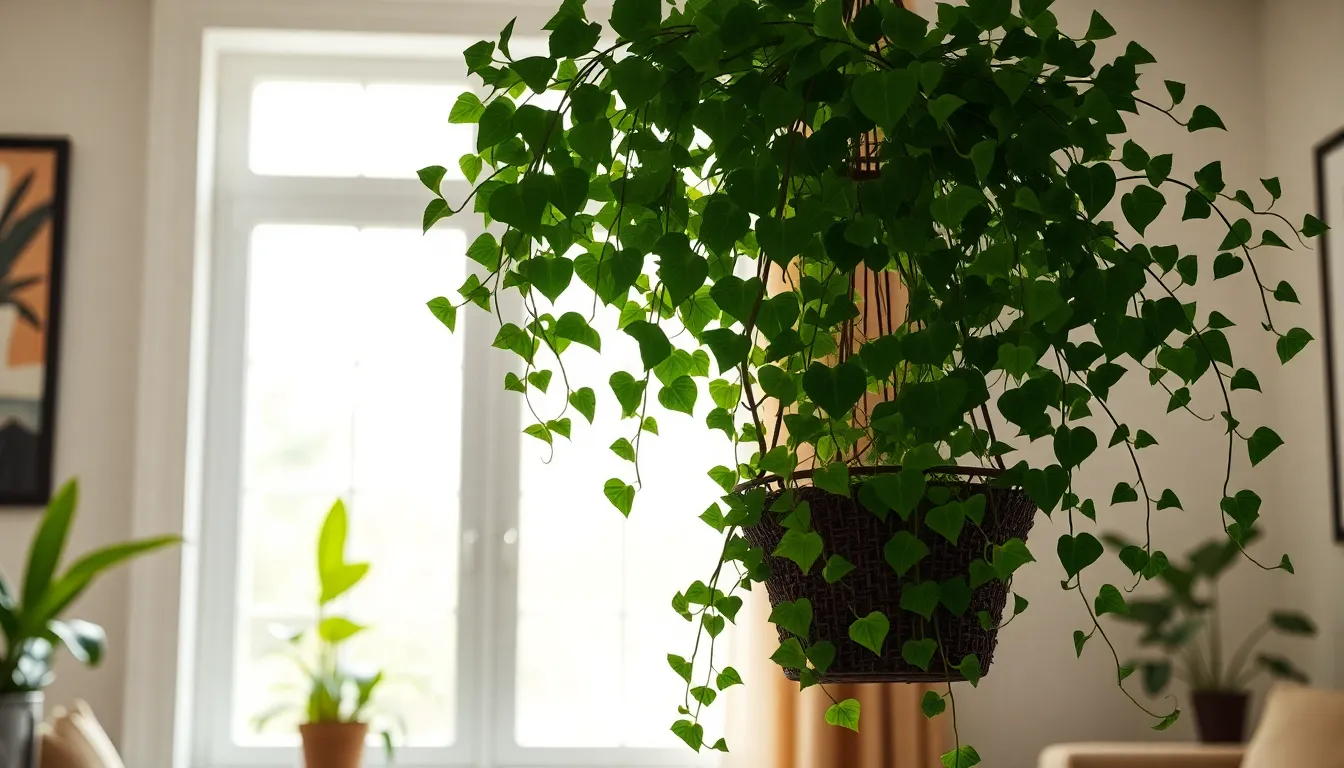
English Ivy stands out as one of nature’s most versatile air purifiers, combining elegant aesthetics with powerful cleaning capabilities. This climbing plant earned recognition in NASA’s groundbreaking 1989 Clean Air Study for its exceptional ability to tackle multiple indoor pollutants.
Reduces Airborne Mold Particles
English Ivy excels at eliminating airborne mold spores that commonly circulate through our homes. The plant’s dense foliage acts as a natural filter, trapping mold particles before they can settle on surfaces or enter our respiratory systems. Research demonstrates that English Ivy can significantly reduce mold concentrations in indoor environments, making it particularly valuable for homes with humidity issues. We’ve found this plant especially effective in areas prone to moisture buildup, such as basements or bathrooms where mold growth typically occurs.
Filters Benzene and Formaldehyde
Benzene and formaldehyde removal represents one of English Ivy’s most impressive air purification capabilities. The plant actively absorbs these harmful volatile organic compounds through its leaves, processing chemicals commonly released by furniture, cleaning products, and synthetic materials. NASA’s research confirmed that English Ivy effectively filters formaldehyde, a pollutant frequently found in household items like particleboard and carpeting. Also, the plant tackles benzene emissions from paints, plastics, and rubber products, continuously working to reduce these toxic compounds in our living spaces.
Grows Well in Hanging Baskets
Hanging basket cultivation makes English Ivy both practical and decorative for indoor air purification. The plant’s trailing growth pattern creates maximum surface area for air contact, improving its pollutant absorption capabilities. We recommend placing hanging baskets in areas with good air circulation to optimize the plant’s cleaning efficiency. English Ivy thrives in indirect sunlight, making it perfect for suspending near windows or in well lit corners where it can cascade gracefully while purifying the surrounding air. Its low maintenance requirements and adaptability to various light conditions make hanging basket growing an ideal choice for busy households seeking natural air purification.
Bamboo Palm: Tropical Air Purifier for Large Spaces
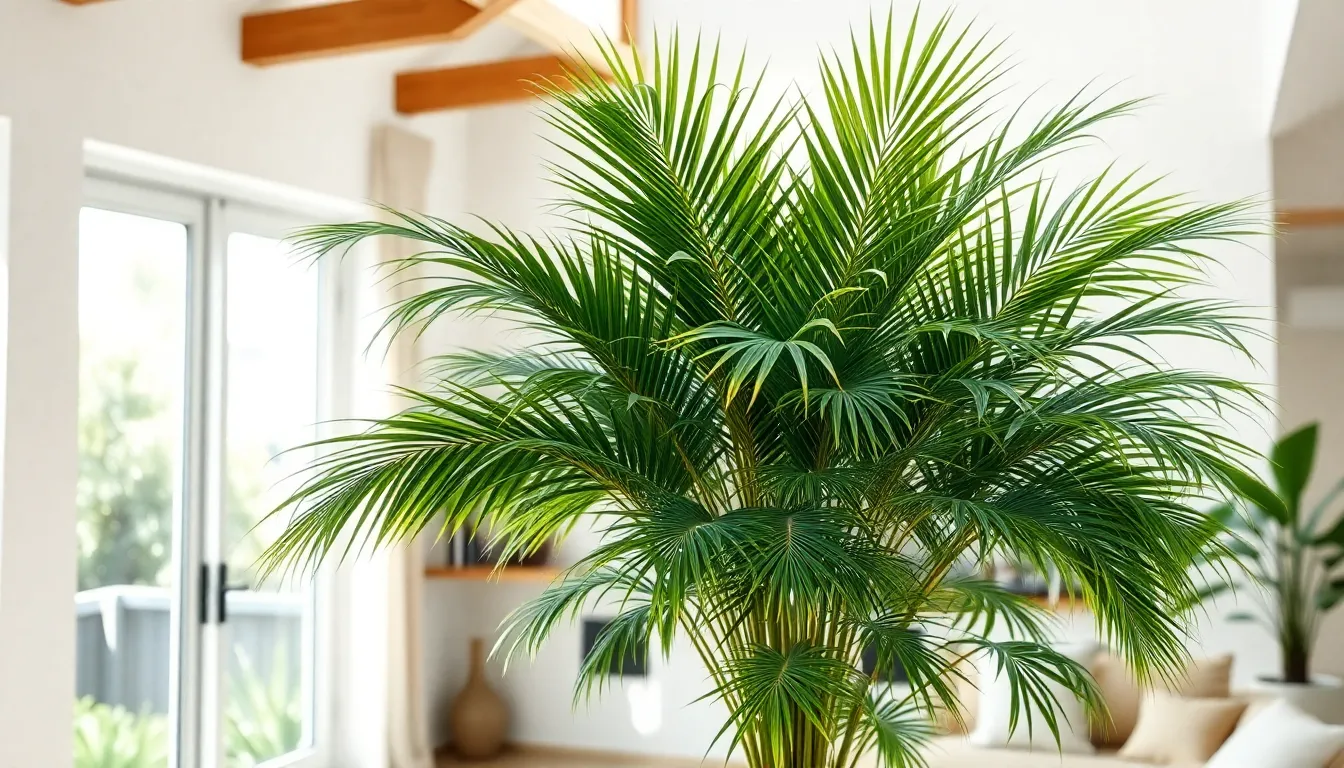
The Bamboo Palm (Chamaedorea seifrizii) stands out as one of the most effective air purifying plants for spacious indoor environments. NASA’s Clean Air Study specifically identified this tropical beauty as a powerful natural filter for large rooms and open living areas.
Removes Benzene, Trichloroethylene, and Formaldehyde
Bamboo Palms excel at eliminating three particularly harmful volatile organic compounds from our indoor air. Research confirms that these palms effectively absorb benzene through their leaves and root systems, removing this toxic chemical commonly found in household cleaners and synthetic materials. Trichloroethylene, a pollutant present in adhesives and paints, gets filtered out continuously by the plant’s natural processes. Formaldehyde removal occurs through the palm’s specialized ability to process this dangerous compound released by furniture, carpets, and building materials.
The plant’s broad fronds maximize surface area contact with contaminated air, allowing for optimal pollutant absorption. Microorganisms in the palm’s soil work alongside the plant to break down these toxic compounds, creating a comprehensive air cleaning system. Studies show that a single mature Bamboo Palm can significantly reduce concentrations of these three major indoor air pollutants in rooms up to 200 square feet.
Adds Tropical Ambiance to Indoor Spaces
Bamboo Palms transform any room into a tropical paradise with their elegant, feathery fronds and graceful appearance. These palms create an immediate vacation like atmosphere, bringing the serenity of tropical destinations directly into our homes. Their lush green foliage adds natural beauty that complements both modern and traditional interior design styles.
The plant’s arching fronds move gently with air circulation, creating subtle movement that enhances the calming effect of indoor spaces. Multiple stems cluster together naturally, forming an impressive display that serves as a living focal point in any room. Interior designers frequently recommend Bamboo Palms for their ability to soften harsh architectural lines while adding organic texture to indoor environments.
Grows Up to 12 Feet Tall Indoors
Bamboo Palms reach impressive heights of up to 12 feet when grown indoors, making them ideal statement plants for large spaces. Their substantial size allows them to purify air more effectively than smaller houseplants, processing greater volumes of indoor air through their extensive foliage. Growth occurs steadily over several years, with mature plants developing multiple stems that create a full, bushy appearance.
These palms thrive in bright, indirect light conditions commonly found in spacious living rooms, offices, and atriums. Proper spacing becomes important as they mature, requiring at least 6 feet of clearance around the plant for optimal growth and air circulation. Their impressive stature makes them perfect for filling empty corners in large rooms or creating natural room dividers in open floor plans.
Dracaena: Colorful Foliage With Clean Air Benefits
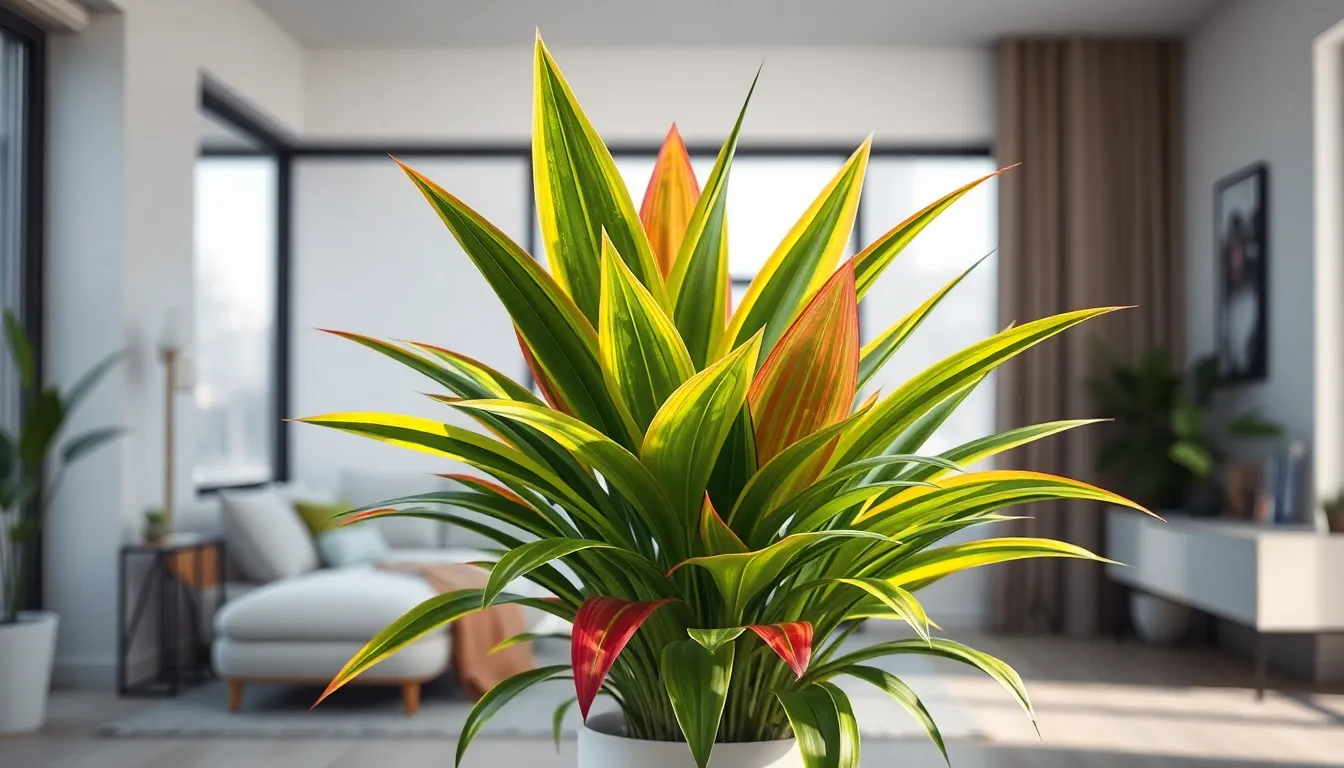
Dracaena stands out as an exceptional choice for those seeking both aesthetic appeal and effective air purification in their indoor spaces. This versatile plant combines striking visual variety with proven toxin removal capabilities.
Eliminates Trichloroethylene and Xylene
Dracaena effectively removes two particularly harmful indoor air pollutants: trichloroethylene and xylene. These dangerous chemicals commonly enter our homes through household products, paints, and synthetic materials, creating invisible health risks. NASA’s Clean Air Study specifically identified dracaena as one of the top performers for eliminating these toxins from indoor environments.
Trichloroethylene exposure can cause dizziness, headaches, and respiratory irritation when present in enclosed spaces. Xylene, another volatile organic compound, contributes to eye and throat irritation while potentially affecting the central nervous system. Dracaena’s natural filtering system continuously absorbs these pollutants through its leaves, converting them into harmless compounds and providing cleaner air for you and your family.
Comes in Multiple Varieties and Colors
Dracaena offers remarkable diversity with its many varieties and striking color combinations. Popular varieties include Dracaena marginata with its distinctive red-edged leaves, Dracaena fragrans featuring broad green and yellow striped foliage, and Dracaena reflexa showcasing vibrant green and cream patterns.
Each variety brings unique aesthetic qualities to your interior design while maintaining the same air-purifying benefits. Dracaena marginata creates dramatic vertical lines with its spiky foliage, while Dracaena fragrans provides fuller, more tropical appearances. The colorful leaf patterns range from deep emerald greens to bright yellows and creamy whites, allowing you to select varieties that complement your existing décor perfectly.
Tolerates Low Light and Infrequent Watering
Dracaena thrives in low light conditions, making it ideal for offices, apartments, and rooms with limited natural sunlight. This adaptability allows you to place these air purifiers in locations where other plants might struggle, such as interior hallways, corner spaces, or north-facing rooms.
Watering requirements remain minimal, with most dracaena varieties needing water only when the top inch of soil feels dry. This typically translates to watering every 1-2 weeks, depending on your home’s humidity levels and temperature. The plant’s drought tolerance makes it perfect for busy lifestyles or frequent travelers who can’t maintain daily plant care routines. Overwatering poses more risk than occasional dryness, so err on the side of less frequent watering for optimal health.
Golden Pothos: Trailing Vine for Versatile Air Cleaning
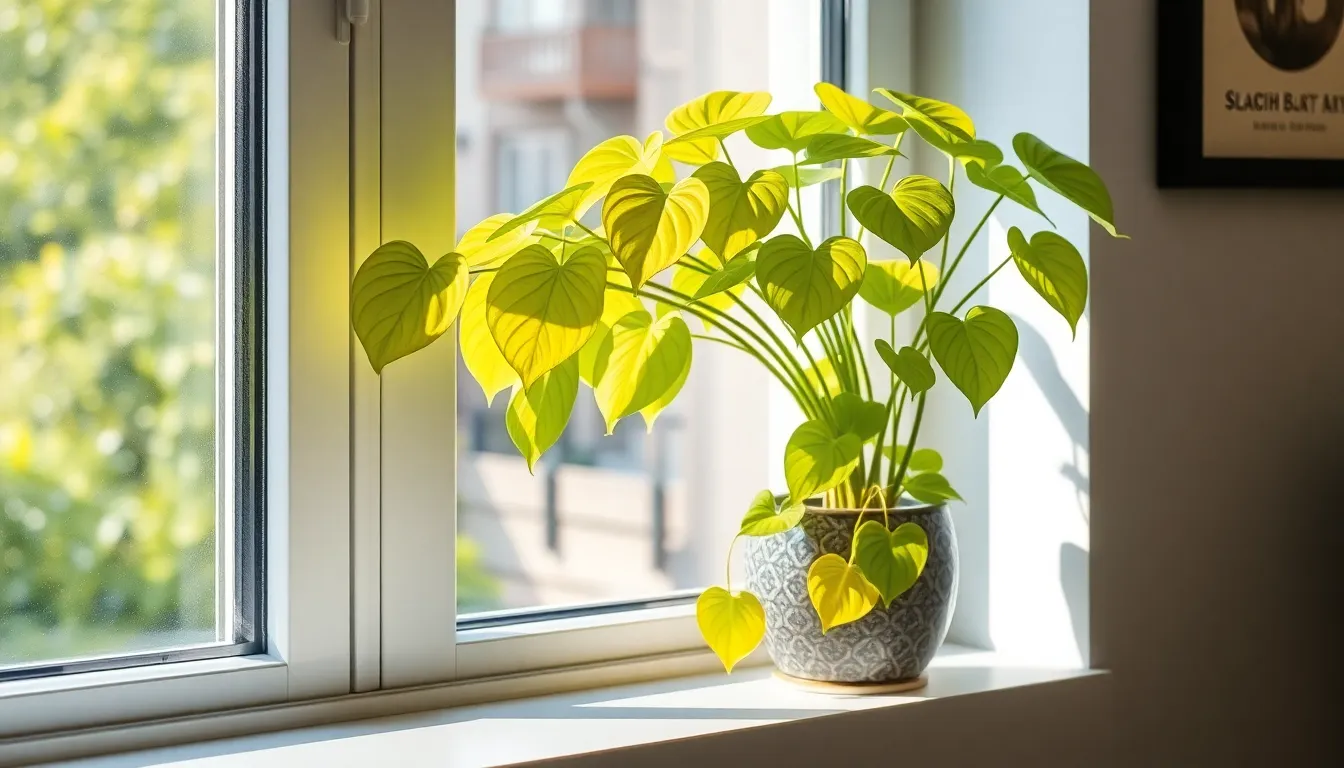
Golden pothos stands out as one of the most effective air-purifying plants, combining exceptional cleaning capabilities with stunning visual appeal. This trailing vine offers multiple benefits that make it an ideal choice for improving indoor air quality.
Removes Formaldehyde, Benzene, and Xylene
Golden pothos excels at eliminating three major indoor air pollutants that commonly affect our homes. NASA’s Clean Air Study specifically highlighted this plant’s ability to remove formaldehyde, benzene, and xylene from indoor environments. Formaldehyde enters our homes through furniture and synthetic materials, while benzene comes from cleaning products and paints. Xylene originates from household products and synthetic fabrics, creating harmful indoor air conditions.
Carbon monoxide absorption adds another layer of protection, making golden pothos particularly valuable for comprehensive air cleaning. The plant’s heart-shaped leaves can grow up to 20 inches in length when mature, maximizing the surface area available for pollutant absorption. Each leaf works continuously to filter volatile organic compounds that pose health risks to our families.
Grows in Water or Soil
Golden pothos demonstrates remarkable adaptability by thriving in both water and soil environments. We can grow this versatile plant in a simple glass container filled with water, making it perfect for tabletop displays or windowsill arrangements. Soil cultivation works equally well, allowing the plant to develop stronger root systems and larger foliage.
Water propagation offers an excellent way to expand our collection, as golden pothos readily develops roots when placed in clean water. This dual growing capability means we can easily move plants between different containers based on our decorating needs. The plant’s flexibility makes it suitable for various indoor spaces, from kitchens to living rooms.
Perfect for Beginners and Busy Lifestyles
Golden pothos requires minimal maintenance while delivering maximum air-cleaning benefits. Watering becomes simple with this plant’s clear signals – we only need to water when the soil feels dry to the touch. The plant tolerates lower light conditions, humidity variations, and temperature fluctuations that would stress other houseplants.
Occasional trimming helps manage growth and maintains the plant’s attractive appearance, fitting perfectly with our busy schedules. Golden pothos adapts to various growing conditions without requiring constant attention or specialized care routines. This low-maintenance nature makes it an excellent choice for first-time plant owners who want effective air purification without complicated care requirements.
Conclusion
Creating cleaner indoor air doesn’t require expensive equipment or complex systems. We’ve shown you how these remarkable plants can transform your living space into a healthier environment while adding natural beauty to your home.
The best part? Most of these air-purifying champions require minimal care and thrive in typical indoor conditions. Whether you’re dealing with a small apartment or a spacious home you can find the perfect plant match for your lifestyle and space requirements.
Start with just one or two plants that appeal to you most. As you experience the benefits firsthand you’ll likely want to expand your collection. Your lungs will thank you for making this simple yet powerful investment in your health and well-being.
Frequently Asked Questions
What makes indoor air more polluted than outdoor air?
Indoor air can be more polluted due to common household items releasing harmful chemicals like formaldehyde, benzene, and ammonia. These toxins come from furniture, cleaning products, synthetic fabrics, and building materials that continuously emit volatile organic compounds in enclosed spaces.
Which houseplant is best for beginners who want to purify air?
The snake plant is ideal for beginners as it’s extremely low-maintenance, requiring water only every 2-3 weeks. It thrives in low light conditions and effectively removes formaldehyde and benzene while purifying air in rooms up to 100 square feet.
How do houseplants actually clean the air?
Houseplants clean air by absorbing harmful chemicals through their leaves and roots, then filtering out toxins like formaldehyde, benzene, and xylene. NASA’s Clean Air Study confirmed that specific plants can remove multiple pollutants simultaneously, naturally purifying indoor environments.
What is the most effective air-purifying plant for large rooms?
The Bamboo Palm is most effective for large spaces, capable of purifying rooms up to 200 square feet. It removes benzene, trichloroethylene, and formaldehyde with its broad fronds that maximize surface area for pollutant absorption.
Can houseplants help with dry indoor air?
Yes, Boston ferns are particularly effective at addressing dry air. They release moisture through their leaves, naturally increasing humidity levels while filtering formaldehyde and xylene. They’re especially beneficial in rooms with new furniture or recent renovations.
Which plants are best for bathrooms and humid areas?
English Ivy is ideal for humid areas like bathrooms and basements because it effectively reduces airborne mold particles. It also filters benzene and formaldehyde while thriving in indirect sunlight with minimal maintenance requirements.
Do air-purifying plants require special care?
Most air-purifying plants are low-maintenance. Snake plants need water every 2-3 weeks, peace lilies signal when they need water through drooping leaves, and Golden Pothos can even grow in water. Most prefer bright, indirect light.
How many plants do I need to purify my home’s air?
The number depends on room size and plant type. One snake plant can purify up to 100 square feet, while a Bamboo Palm can handle up to 200 square feet. Generally, 1-2 plants per room provide noticeable air quality improvements.

